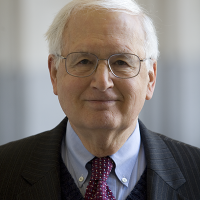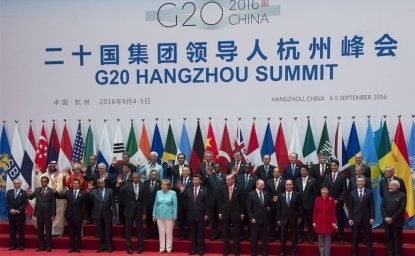Ambassador J. Stapleton Roy presented this keynote address at The Future of U.S. Policy Toward Asia: Implications of the 2016 Elections for Economic and Security Issues. His remarks have been edited for clarity. Roy retired with the rank of Career Ambassador and served as head of mission to Singapore, China, and Indonesia.
We are here today to look at the future of American foreign policy in Asia. The topic is a good one, but our timing is bad. So much depends on the outcome of the U.S. presidential elections in November.
Both candidates will face the same sets of challenges and opportunities regardless of which one emerges as the victor. In the case of the Democratic candidate, we have a relatively known quantity, given her four years as Secretary of State during President Obama's first four years. We can make reasonable assumptions about how she will staff her administration and who will end up in key positions in our foreign policy and national security apparatus.
In the case of the Republican candidate, all bets are off. He has no background in foreign policy and national security affairs, other than a brief trip to Mexico a few weeks ago. He has been quick to make pronouncements on foreign policy and national security issues, but has yet to display mastery of any of the relevant subject matter. We have not yet had the debates between the two candidates, which might provide some clues. If elected, it is far from clear how the Republican candidate will staff his administration since so many of the most experienced former officials in his party have repudiated his candidacy. This is an unprecedented state of affairs.
Given these considerations, now is not the time to make predictions about the foreign policy of the new administration. Nevertheless, regardless of who wins in November, we will be dealing with the same world and the same foreign leaders. So let's take a brief look at that world, with special reference to East Asia.
It is not a pretty picture. In the Western Hemisphere, the United States is mired in political dysfunctionality. Our national finances are a mess since intelligent discussion of the proper balance between revenue and expenditure has been taken off the table by making taxation an unmentionable word, except for denunciation. Congress works a three-day week and hasn't passed a budget in years. We are passing on the costs of our military adventures to future generations, and we are mangling our defense budget through sequestration. Neither candidate is talking sensibly about these issues.
In South America, Brazil's economy is sputtering. Africa continues to underperform. The Middle East is in perpetual crisis. And Europe, once a contributor to global stability, is facing two intractable problems: the NATO confrontation with Russia, and the threat that the EU may unravel.
East Asia has the potential to continue to do well if key relationships and friction points are managed properly
That leaves us East Asia, which despite its many problems, remains the principal global bright spot. Unlike the Middle East and Europe, where it is difficult to see a good outcome from their many problems, East Asia has the potential to continue to do well if key relationships and friction points are managed properly. The region escaped the brunt of the 2008 global financial crisis since China’s economy recovered quickly from the downturn, and this helped buoy up the region. The continued US robust security presence, a necessary but not sufficient part of the rebalancing strategy, has served as a check on Chinese exuberance. Economically, the region is still outperforming the rest of the world.
East Asia needs sustained and well-informed policy attention from whatever U.S. administration emerges from our elections in November.
At the same time, missteps in East Asia could have very serious consequences. North Korea’s nuclear weapons and long range missile programs could foment a very dangerous crisis. The strategic rivalry between China and the United States has not yet been stabilized. The downward spiral in Sino-Japanese relations has been arrested, but the relationship is still strained. New uncertainties have emerged in cross-strait relations between Taiwan and the mainland, and the South China Sea has become a cauldron of conflicting territorial claims and major power posturing.
This is a less promising picture than fifteen years ago, when cooperative trends in the region were on the upswing and the ASEAN countries were taking the lead in creating new consultative mechanisms in East Asia. It is clear, therefore, that East Asia needs sustained and well-informed policy attention from whatever U.S. administration emerges from our elections in November.
However, more than attention is required for a successful policy approach in East Asia. First and foremost, the United States needs to adjust its assumptions regarding the region. The new U.S. president who will move into the White House in January 2017 will face a global situation that differs in important respects from the world that we faced eight years ago when President Obama took office. Not all of these changes have been integrated into our thinking:
- The 2008 global financial crisis hit the Western economies particularly hard, enabling China’s GDP to surpass that of Japan and narrow the gap with that of the United States faster than expected. This soon manifested itself in more self-confident and assertive Chinese international behavior.
- The assumptions underlying the rebalancing strategy in East Asia – that is, that we would reduce our security role in the Middle East and that threats in Europe would remain relatively minor – did not pan out. We remain bogged down in the Middle East, and the reckless management of the NATO expansion strategy has triggered a Russian response, accurately predicted by a host of knowledgeable European experts, that has made Europe less secure, is forcing us to divert scarce resources to shore up NATO preparedness, and has produced a dangerous game of high-stakes bluffing on Russia’s borders. This is a fundamental consideration because of the resource implications. The ability of our economy to support our global strategy depends on the willingness of our political system to extract the financial means necessary for such a strategy to be viable, including both the military and non-military components. We are barely funding the military components, while the non-military components are grossly underfunded, as illustrated by the inability of the United States to join the Asia Infrastructure Investment Bank, an initiative that China is backing with tens of billions of dollars. We have already been forced to divert over four billion dollars to our NATO budget because of the confrontation with Russia. In the meantime, we are underfunding the maintenance of our infrastructure by fifty percent. If the new administration does not address these considerations sensibly, we will risk a damaging loss of credibility in our global role.
- China’s rapid military modernization program has eroded U.S. air and sea dominance in the western Pacific. The hard reality is that the PLA’s rapid military modernization over the last 20 years has caused the net change in capabilities to move in favor of China, even though the aggregate capabilities of the U.S. military remain far superior. This trend line is likely to continue in the absence of a severe economic crisis on either side of the Pacific and is having an effect on regional perceptions. We like to think in terms of using our robust military presence in the western Pacific to balance China’s rise. It may be equally true to speak of China’s growing military capabilities as now able to balance the air and sea dominance that we have enjoyed in the region since the end of World War II. Indicative of this trend, the brash and unpredictable new President of the Philippines, an important U.S. regional ally, recently claimed that China now had military superiority in the region in announcing the end of joint U.S.-Philippine joint naval patrols in the South China Sea. [President Rodrigo Duterte] has also announced plans to seek military equipment from China and Russia. I think his assessment of the U.S. military position in East Asia is wrong, but it is disturbing for a U.S. ally to be talking in this fashion.
- China and Russia have been pushed even closer together by Russia’s confrontation with NATO over Ukraine, and the two former enemies are now carrying out joint military exercises in the East and South China Seas. It was, of course, our common perception of the Soviet threat that enabled Washington and Beijing to overcome our differences forty-five years ago. Now Beijing and Moscow are finding a strategic basis for cooperation in their common concern about the potential US threat.
- US efforts over the last 25 years to deter North Korea from developing nuclear weapons and delivery systems have failed. Pyongyang has carried out five nuclear tests and is actively seeking to develop long-range ballistic missiles capable of targeting the continental United States. If Pyongyang succeeds in this quest, it will increase doubts in Japan and South Korea over the credibility of the US nuclear shield over them. This will increase incentives for nuclear proliferation. At the moment the US policy cupboard for dealing with these issues is bare. This issue will require the early attention of the new US administration.
- With respect to Taiwan, after eight years of rapidly expanding trade and investment ties across the Taiwan Strait, there are now growing uncertainties concerning the future course of cross-Strait relations. Beijing has suspended the functioning of the existing cross-Strait consultation mechanisms because of the refusal of Taiwan’s new president to endorse some variant of the 1992 Consensus affirming the one China principle. Although President Tsai Ing-wen campaigned on a platform of maintaining the status quo across the Strait, the weakening of the one-China underpinning for the status quo has raised question marks about the future. The harsh reality is that in the decades ahead Taiwan cannot expect to maintain a satisfactory military balance across the Taiwan Strait given Beijing’s rapidly growing military capabilities. This means that Taiwan’s security will depend to an increasing degree on a combination of deterrence, that is, being strong enough to make a military attack costly, and careful management of the cross-strait relationship with a view to keeping the threat of attack low.
- We should also not underestimate the negative impact on U.S. friends and allies in East Asia of the fact that both US presidential candidates have repudiated the Trans-Pacific Partnership, which represents the vitally important economic aspect of the US rebalancing strategy in East Asia. It is also significant that one of the candidates has implied a lessened commitment to Japan and South Korea, the two key US allies in Northeast Asia, by suggesting that they might need to develop their own nuclear deterrent. The unresolved territorial disputes over land features in the South China Sea are also roiling the waters in that part of East Asia.
These represent some of the challenges that the new US administration will face in East Asia next January. The United States has a strong hand to play, but it will stumble if it refuses to recognize how the region is changing and to adjust its policy approach accordingly. The U.S. hand will be greatly weakened if East Asian countries gain the impression that the United States is turning inward and that its commitment to remaining fully engaged in East Asia is weakening. As a result, a great deal rests on the outcome of the U.S. presidential elections in November.









